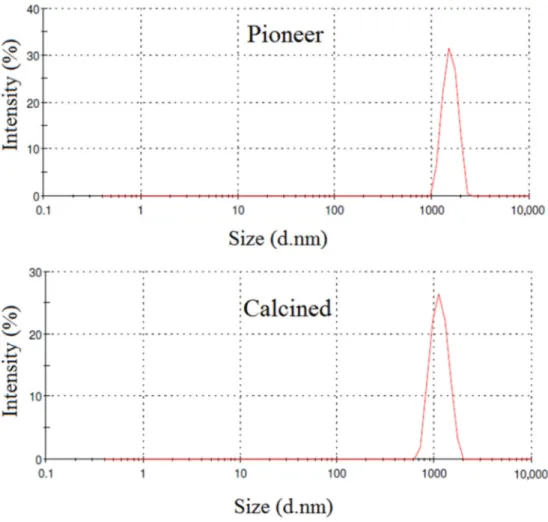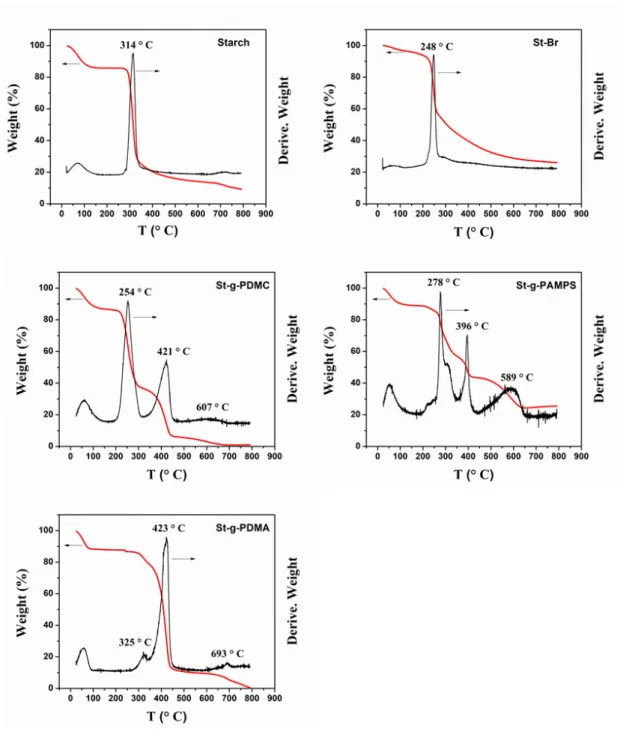Supporting Information
Synthesis of Polymer Grafted Starches and Their
Flocculation Properties in Clay Suspension
Nana Zhao 1, Hani Al Bitar 1, Yunyin Zhu 2,Yuming Xu 2,* and Zhiqing Shi 1,*
1 Energy, Mining & Environment, National Research Council Canada, Vancouver, BC V6T 1W5, Canada;
Nana.Zhao@nrc‐cnrc.gc.ca (N.Z.); hani.albitar@outlook.com (H.A.B.)
2 CanmetENERGY‐ Devon, Natural Resources Canada, 1 Oil Patch Dr., Devon, AB T9G 1A8, Canada;
Yunyin.Zhu@canada.ca
* Correspondence: Zhiqing.Shi@nrc‐cnrc.gc.ca (Z.S.); yuming.xu@canada.ca (Y.X.)
2 of 3
Figure S2. TGA curves of starch, starch‐Br, St‐g‐PDMC, St‐g‐PAMPS, and St‐g‐PDMA.
The thermal stabilities of the original starch, St‐Br and St‐g‐Polymer were studied by thermogravimetric analysis (TGA) in a nitrogen stream at a heating rate of 20 °C/min and depicted in Figure S2, in which the TGA curves were shown in the range of 50−800 °C. The threshold decomposition temperature gives an indication of the highest processing temperature that can be used for the applications of the materials. Starch exhibits two degradation stages. In the first stage, there is a weight loss of 14.3% which is due to water evolving in the range of 50 °C−150 °C. The second significant weight loss of 76.5% begins at about 290 °C. Correspondingly, there is a peak in the derivative thermogravimetric curve at 314 °C due to the decomposition of starch. In comparison, the weight loss of St‐Br occurred at ~230 °C and ultimately lost 74% of its weight. The TGA curves for St‐ g‐PDMC show four stages of weight loss, indicating that the grafting of PDMC onto starch backbone significantly changed the thermal stability of the starch. In the first stage, a weight loss of 13.4 % was also due to the loss of absorbed and bounded water. In the second stage, the quickest weight losses which occurred at ~230 °C was due to the thermal degradation of starch backbone. In the third stage,
3 of 3
the quickest weight losses occurred at ~400 °C and are possibly assigned to the decomposition of the graft chains of PDMC. In the last stage, the peak weight loss at ~600 °C represents the degradation of the residual polymers. The polymer grafting percentage of St‐g‐PDMC can be estimated as of 42 wt% by TGA. The decomposition steps were also observed in the TGA curves of St‐g‐PAMPS and St‐g‐ PDMA. For St‐g‐PAMPS, the first stage occurred at ~260 °C, corresponding to the decomposition of Starch‐Br. The second stage occurred at ~380 °C is possibly due to the decomposition of sulphonic acid groups. In the last stage, the peak weight loss at 589 °C represents the degradation of all the polymers. For St‐g‐PDMA, the first stage related to the decomposition of St‐Br was not clear, but the second stage occurred at ~400 °C, and is similar to the other co‐polymers. Based on TGA data, the polymer grafting percentages for St‐PAMPS and St‐PMDA are estimated as of ~50%.

